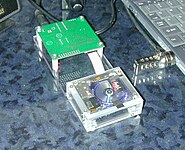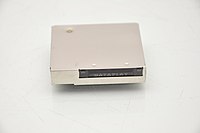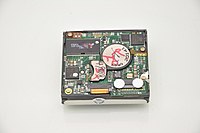DataPlay
| Company type | Incorporation |
|---|---|
| Founded | 1998[1] |
| Founder | Steve Volk |
| Headquarters | |
Key people | Bill Almon, Jr., CEO and President Jeff Roberts, CFO |
| Products | DataPlay Engine DataPlay 500MB Optical Media |
Number of employees | ~30 (2006) |
| Website | www.DataPlay.com (defunct) |
| Optical discs |
|---|
DataPlay is an optical disc system developed by DataPlay Inc. and released to the consumer market in 2002. Using tiny (32mm diameter) disks enclosed in a protective cartridge storing 250MB per side, DataPlay was intended primarily for portable music playback. However, it could also store other types of data using pre-recorded disks and user-recorded disks (and disks that combined pre-recorded information with a writable area).[2] It would also allow for multisession recording.[1] DataPlay Inc. was founded in 1998 by Steve Volk. The company's namesake optical disc won the CES Best of Show award 2001.[3]
DataPlay also included an elaborate digital rights management system designed to allow consumers to "unlock" extra pre-recorded content on the disk at any time, through the internet, following the initial purchase. It was based on the Secure Digital Music Initiative's DRM system.[2] DataPlay's DRM system was one of the reasons behind its attractiveness to the music industry.[4] It also included a proprietary file system, DataPlay File System (DFS) which natively supported DRM. By default, it would allow up to 3 copies to other DataPlay discs, without allowing any copies to CDs.[5]
History
[edit]DataPlay Inc. was founded by Steve Volk in 1998.[6] Volk had founded DataPlay in the aftermath of his second company Intégral Peripherals going bankrupt in 1998. Intégral was the first to manufacture 1.8-inch hard drives—at the time the smallest form factor for hard drives—for laptops and other mobile computing devices, starting in 1992. Volk intended for Intégral to supplant the industry-standard 2.5-inch hard drive form factor introduced by PrairieTek—the first company that Volk had co-founded. After the failure of Intégral, Volk decided to focus on the optical media sector.[7]
The recorded music industry was initially generally supportive of DataPlay, and a small number of pre-recorded DataPlay disks were released, including the Britney Spears album Britney. Graphics on press releases show that Sting and Garth Brooks were also set to have DataPlay releases.[8] In 2021 the first DIY DataPlay album was released by the experimental rave producer Backmasker.[9][10] However, as a pre-recorded format, DataPlay was a failure. The company closed due to a lack of funding.[11][12] In 2003 a company called DPHI bought DataPlay's intellectual property and reintroduced it at CES 2004. The company swapped DataPlay's DFS file system for the FAT file system. Again, they were marketed as a cheaper alternative to memory cards, with a device being designed that would allow users to transfer data from an SD card to a cheaper DataPlay disc. Each disc would hold 500 megabytes of data and be sold at just US$4.50. DPHI also prototyped 750 megabyte DataPlay discs and announced plans for 2 and 7 gigabyte discs, the latter of which would use a blue-violet semiconductor laser, just like Blu-ray.[13]
Very few products were seen on the market that could write data to these discs. Most notable was the Topy Mini Writer, which retailed for $130 (USD) and housed an optical pickup unit (image No.4) with a USB interface board, allowing the use of DataPlay discs much like other end-user writable optical media (e.g., CD-Rs). Other products were the iriver IDP-100[14] and the MTV Video Device "MTV FLIP", which both housed the prototype-based model (image No.2).[citation needed]
DataPlay discs were first proposed as a low-cost alternative to memory cards, which used to cost US$3 per megabyte. Blank DataPlay discs, by comparison, would hold 500 megabytes of data at US$10 per disc. They are also expected to have a 100-year lifespan.[2][15][1] The discs would be made out of polycarbonate, just like CDs, but would be just 0.6mm thick, just like one half of a DVD (DVDs are made up of two halves that are bonded using glue; usually only one (side) contains data).[5] Rewritable DataPlay discs would be similar to CDs, using a phase change alloy protected by a silicon oxide layer.[5] Mastered (replicated) DataPlay discs would combine both pits and lands to store mastered data and grooves containing a wobble frequency to store rewritable data. Like on CDs, the wobble frequency would store time data to position the laser on the disc precisely.[5][16]
It has two rewritable areas: one for user data and the other for encrypted data. The latter of which would hold the decryption keys necessary to unlock the extra content.[5] They also have a burst cutting area to uniquely identify each disc.[5] DataPlays can transfer data at 1 megabyte per second.[3][17]
Other trademark names:[citation needed]
- DaTARIUS
- DPHI
- DataPlay
Gallery
[edit]-
DataPlay optical drive engine development photo of a development platform for testing and demo
-
DataPlay optical drive engine internals viewed from above a unit produced without any top cover; above the circular piece is the laser pickup. The laser pickup is built on a piece of silicon.[18]
-
DataPlay optical drive engine with its case (a never-used piece from a private collection)
-
DataPlay optical drive engine top (same as No.3)
-
DataPlay optical drive engine bottom (same as No.3) The large coin-like object is a motor for spinning the disc, and the metal piece at its left is a magnet; the laser pickup of the drive is mounted on an arm that is moved using a mechanism, the latter two of which are reminiscent of that of modern hard disks.
References
[edit]- ^ a b c "DataPlay Discs Put a New Spin on Digital Music - The Washington Post". The Washington Post. Archived from the original on 2020-04-16.
- ^ a b c "PCWorld.com - DataPlay Shows Breakthrough in Storage Media". June 8, 2001. Archived from the original on June 8, 2001.
- ^ a b "Consumer Electronics Show 2001". HowStuffWorks. January 11, 2001. Archived from the original on October 28, 2016. Retrieved April 16, 2020.
- ^ "New disc format enters crowded market". Archived from the original on 2020-04-13. Retrieved 2020-04-16.
- ^ a b c d e f "Archived copy" (PDF). Archived (PDF) from the original on 2016-06-24. Retrieved 2020-04-16.
{{cite web}}: CS1 maint: archived copy as title (link) - ^ Chediak, Mark (September 15, 2001). "A cross section of privately held storage companies". Red Herring. RHC Media: 88 – via Gale.
- ^ Forgrieve, Jane (December 30, 2002). "Downsizing DataPlay". Rocky Mountain News. Tribune Publishing: 1B – via Gale.
- ^ . 2001-06-12 https://web.archive.org/web/20010612221719/http://www.dataplay.com/pdf/en/DataPlay_Overview.pdf. Archived from the original (PDF) on 2001-06-12. Retrieved 2021-04-05.
{{cite web}}: Missing or empty|title=(help) - ^ Backmasker -The Anti Clutter Weapon ( DataPlay )Breakbeat Hardcore on worlds rarest music format, archived from the original on 2021-12-21, retrieved 2021-04-26
- ^ admin (2024-08-24). "DataPlay: The rise and fall of a Forgotten Optical Disc Technology". Backmasker. Retrieved 2024-09-14.
- ^ "DataPlay shuts down operations". October 3, 2002. Archived from the original on August 12, 2018. Retrieved April 16, 2020.
- ^ "Cash crunch puts media format on hold - Tech News - CNET.com". October 17, 2002. Archived from the original on October 17, 2002.
- ^ "DataPlay Discs Stage a Comeback". PCWorld. October 8, 2004. Archived from the original on March 31, 2019. Retrieved April 16, 2020.
- ^ "iRiver iDP-100 MP3 player". PC World. Archived from the original on 2021-07-09. Retrieved 2020-04-16.
- ^ "PCWorld.com - DataPlay's Tiny Media to Ship Next Quarter". November 16, 2001. Archived from the original on November 16, 2001.
- ^ "DataPlay signs distribution deal with Imation - Tech News - CNET.com". September 12, 2001. Archived from the original on September 12, 2001.
- ^ "DataPlay, Imation play with tiny CDRs". June 19, 2001. Archived from the original on August 12, 2018. Retrieved April 16, 2020.
- ^ "Archived copy" (PDF). Archived (PDF) from the original on 2016-06-24. Retrieved 2020-04-16.
{{cite web}}: CS1 maint: archived copy as title (link)
External links
[edit]- Official Site (defunct)
- Techmoan: DataPlay: The futuristic optical disc format that time forgot, YouTube, 8 November 2018


![DataPlay optical drive engine internals viewed from above a unit produced without any top cover; above the circular piece is the laser pickup. The laser pickup is built on a piece of silicon.[18]](http://up.wiki.x.io/wikipedia/commons/thumb/8/89/DataPlayProto.jpg/200px-DataPlayProto.jpg)


